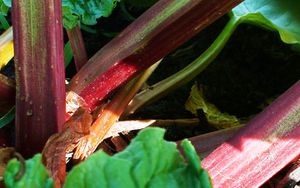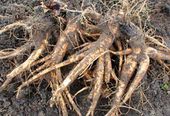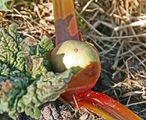Rhubarb
From eagle-rock.org
| Rhubarb | |
|---|---|

| |
| Rhubarb stalk | |
| Scientific classification | |
| Kingdom: | Plantae |
| Order: | Caryophyllales |
| Family: | Polygonaceae |
| Genus: | Rheum |
| Species: | R. rhabarbarum |
| Binomial name | |
| Rheum rhabarbarum | |
Chunks of information
- Rhubarb likes a moist, humus-rich soil with lots of compost.
- The roots can be dried and kept as medicine.
- We use the stalks of the plants mostly by adding them to strawberry pies.
- From http://en.wikipedia.org/wiki/Rhubarb - Rhubarb can be used as a strong laxative. Its roots have been used as a laxative for at least 5,000 years. The roots and stems are rich in anthraquinones, such as emodin and rhein. These substances are cathartic and laxative, which explains the sporadic use of rhubarb as a dieting aid. Rhubarb roots are used in traditional Chinese medicine; rhubarb also appears in medieval Arabic and European prescriptions. The rhizomes ('roots') contain stilbenoid compounds (including rhaponticin) which seem to lower blood glucose levels in diabetic mice.
- Mrs. Grieve (A modern herbal) - http://botanical.com/botanical/mgmh/r/rhubar14.html says about the Turkish rhubarb: Medicinal Action and Uses---Astringent, tonic, stomachic, aperient. In large doses, Rhubarb powder acts as a simple and safe purgative, being regarded as one of the most valuable remedies we possess, effecting a brisk, healthy purge, without clogging the bowels and producing constipation, too often consequent upon the use of the more active purgatives. It is especially useful in cases of diarrhea, caused by an irritating body in the intestines: the cause of irritation is removed and the after-astringent action checks the diarrhea.
- I crumble a piece of ordinary blackboard chalk and put that with the rhubarb when i cook it. Then you only need a small amount of honey to sweeten it. The chalk neutralizes the oxalic acid in the rhubarb. It's healthier that way and easier to sweeten. Don't put in too much though because you'll be eating a dish of chalk.
Gallery
See also
External links
- Rhubarb Wikipedia




